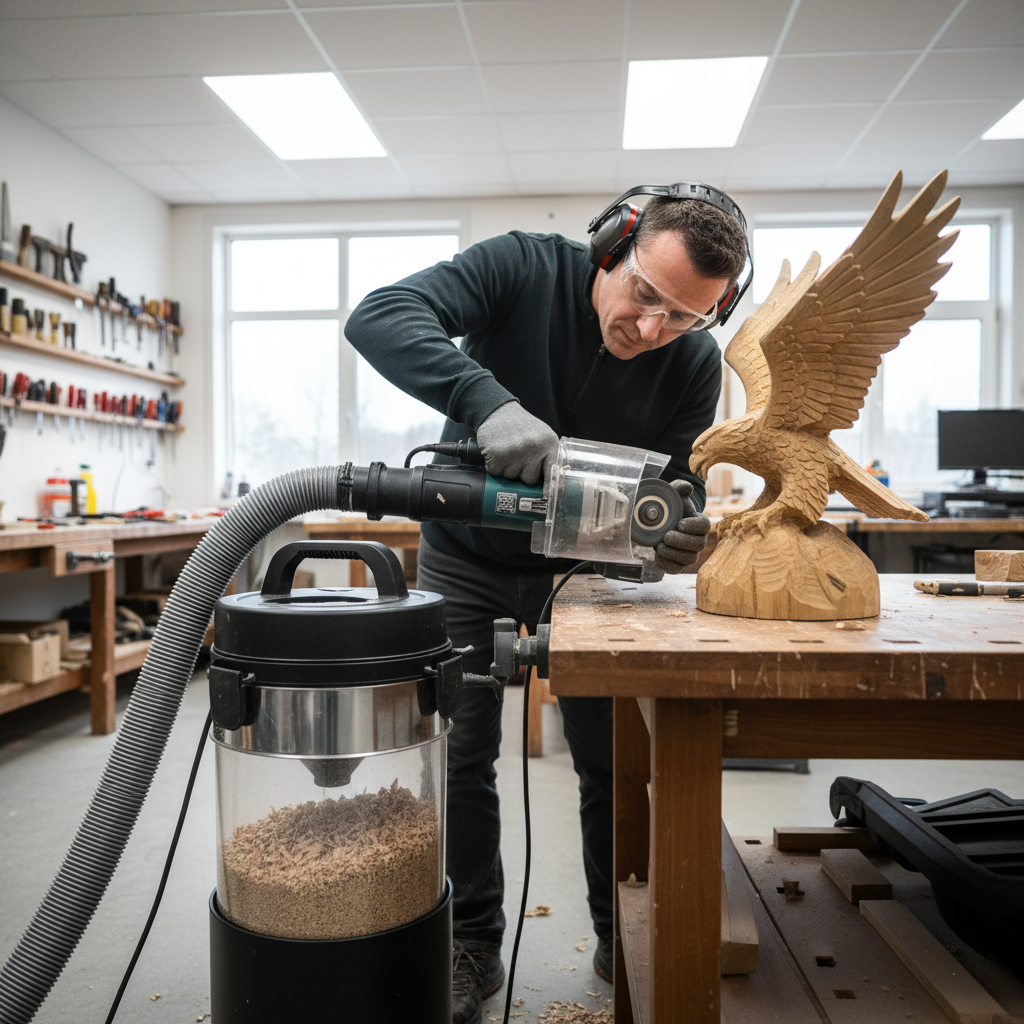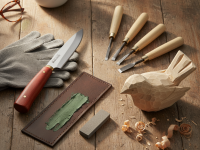Hey there, fellow woodcarvers and creative souls! If you’re anything like I used to be, your workshop probably looks like a snow globe after a particularly enthusiastic carving session. Wood dust, right? It gets everywhere – on your tools, in your hair, clinging to your clothes, and worst of all, filling your lungs. For years, I just accepted it as part of the deal. Wearing a flimsy dust mask and sweeping up mountains of shavings was my routine. But then, something clicked, and I discovered the game-changer: a vacuum wood carving tool set. And let me tell you, it transformed not just my workspace, but my entire carving experience.
I’m here today to share my journey, my insights, and why I believe embracing dust-free carving isn’t just a luxury, but a necessity for anyone serious about their craft and their health. So, let’s dive in!
Why Dust-Free Carving Isn’t Just a “Nice-to-Have” Anymore
Before we talk about the tools, let’s get real about the problem. Wood dust isn’t just messy; it’s a genuine health hazard. As someone who spends hours hunched over a piece of wood, I’ve had my share of itchy eyes, congested noses, and even that persistent “woodworker’s cough.” It’s not fun, and it’s certainly not sustainable in the long run.
Here’s why I firmly believe you need to tackle dust head-on:
-
Your Health is Your Wealth
This is paramount. Fine wood dust can penetrate deep into your lungs, leading to respiratory issues ranging from asthma to more severe conditions. Different wood types pose different risks, some even being sensitizers or irritants. Why risk it when there’s a solution?
-
A Clean Workspace is a Happy Workspace
Imagine being able to see your lines clearly without a layer of fine dust obscuring your work. Imagine not having to spend precious carving time sweeping and vacuuming. A dust-free environment isn’t just aesthetically pleasing; it actually boosts your productivity and allows for more focused, precise work. Plus, your significant other might appreciate less sawdust tracked into the house!
-
Better Vision, Better Precision
When dust isn’t constantly flying around and settling on your carving, you have a much clearer view of your work. This means fewer mistakes, better detail, and ultimately, higher quality finished pieces. It’s like switching from a blurry old TV to a crisp HD display – once you experience it, there’s no going back.
Unpacking the Magic: What is a Vacuum Wood Carving Tool Set?
So, what exactly are we talking about here? Essentially, a vacuum wood carving tool set integrates a dust collection system directly with your carving tool. It’s not just a shop vac ruing in the corner; it’s a targeted, efficient approach to capturing dust at its source.
A typical set-up usually includes:
-
The Carving Tool Itself
This could be an angle grinder fitted with carving discs, a rotary tool, or even specialized power carvers. The key is that it’s designed to accept a dust shroud.
-
The Dust Shroud or Hood
This is the clever bit! It’s an attachment that fits around the cutting end of your carving tool. It has an opening for your carving bit and an port for a vacuum hose. As you carve, the shroud acts like a mini containment unit, directing the wood dust directly into the vacuum.
-
The Vacuum System
This can range from a dedicated dust extractor designed for fine wood dust (which I highly recommend) to a powerful shop vacuum. The important thing is sufficient suction to pull the dust away effectively.
-
The Hose and Adapters
Flexible hoses coect the shroud to the vacuum, often with various adapters to ensure a snug fit across different tool brands and models.
The principle is simple: as soon as the carving bit creates dust, the vacuum sucks it up before it can even become airborne. It’s like having an invisible helper constantly cleaning up after you.
My Personal Journey: Embracing the Dust-Free Revolution
I remember the days vividly. My small garage workshop, coated in a fine, golden layer of oak dust after an afternoon session. I’d cough, clear my throat, and resign myself to a half-hour cleanup. I used cheap paper masks, which, frankly, didn’t do much. I even tried setting up a box fan with a filter, but it was just pushing dust around rather than containing it.
My turning point came after a particularly nasty bout of bronchitis. My doctor, knowing my hobby, gently but firmly suggested I re-evaluate my workshop safety. That’s when I started researching. I saw videos of professional carvers working in seemingly pristine environments, and I thought, “How do they do that?!” The answer, almost universally, was integrated dust collection.
I started small, with a basic shroud for my angle grinder and an upgrade to a more powerful shop vac with a HEPA filter. The initial investment felt a bit steep, I won’t lie. But the first time I lifted my carving tool after a solid hour of work and saw hardly any dust on my bench – just the perfectly carved piece – I was genuinely stued. It was a “where have you been all my life?!” moment.
The difference was immediate and profound. My breathing felt clearer. My eyes stopped itching. My workshop stayed cleaner for longer. I found myself actually enjoying the carving process more because I wasn’t constantly distracted by the mess or worried about my health. It wasn’t just a tool; it was an investment in my passion and my well-being.
The Key Benefits I’ve Discovered (And You Will Too!)
Since making the switch, I’ve identified several game-changing benefits that go beyond just “less dust.”
-
Unbeatable Health Protection
This is number one for a reason. Knowing that I’m significantly reducing my exposure to harmful airborne particles gives me immense peace of mind. I can carve longer and more frequently without the worry of respiratory irritation or long-term damage.
-
Crystal-Clear Visibility
With dust being sucked away instantly, my carving lines and workpiece surface remain visible and unobstructed. This translates directly to enhanced precision and the ability to refine details much more effectively. No more guessing what’s beneath that thin layer of debris!
-
Massive Time Savings on Cleanup
Seriously, this is a lifesaver. What used to be a 20-30 minute cleanup operation is now a quick wipe-down. This means more time carving, less time sweeping, and more time enjoying the fruits of my labor.
-
Extended Tool Life
Dust is abrasive. When it gets into the motors and moving parts of your carving tools, it causes wear and tear. By capturing the dust, you’re not just protecting yourself, you’re protecting your expensive equipment, leading to a longer lifespan for your tools.
-
Improved Air Quality Throughout Your Home
Even if your workshop is separate, fine dust has a way of migrating. With a good dust collection system, you’ll notice a significant improvement in the ambient air quality, not just in your workshop, but potentially throughout your home.
Choosing Your Own Dust-Free Setup: What to Look For
Ready to make the leap? Fantastic! Here’s what I’ve learned about selecting the right vacuum wood carving tool set for your needs:
-
Power of the Vacuum/Dust Extractor
Don’t skimp here. A weak shop vac won’t cut it for fine wood dust. Look for a dedicated dust extractor with a high CFM (Cubic Feet per Minute) rating for airflow and good static pressure. A multi-stage filtration system, ideally with a HEPA filter, is a must for capturing those tiny, dangerous particles.
-
Quality of the Dust Shroud
The shroud is critical. It needs to be durable, fit your tool securely, and effectively encompass the carving area. Look for shrouds made from sturdy plastics or metals that can withstand the vibrations and occasional knocks of carving. Some shrouds have brushes around the edge, which I find incredibly effective at containing dust right at the cutting point.
-
Hose Diameter and Flexibility
A larger diameter hose (e.g., 1.5 to 2.5 inches) generally provides better airflow. However, you also need flexibility so it doesn’t hinder your movement while carving. Look for anti-static hoses to prevent static shock and reduce dust clinging inside the hose.
-
Tool Compatibility
Ensure that the vacuum attachment system is compatible with your existing or desired carving tools. Many brands offer universal adapters, but dedicated systems often work best.
-
Noise Levels
Dust extractors can be noisy. If you carve for long periods, consider models that prioritize quieter operation, or invest in good hearing protection.
Tips for Maximizing Your Dust Collection
Even with the best equipment, a few habits can make a huge difference:
-
Positioning is Key
Always try to position the dust shroud as close as possible to the point of carving. The closer the capture, the more effective the system.
-
Regular Filter Maintenance
A clogged filter significantly reduces suction. Clean or replace your filters regularly according to the manufacturer’s recommendations. I usually tap my filter clean after every major carving session.
-
Empty Your Dust Collector Often
Don’t let the collection bag or bin get too full. A full collector impedes airflow and reduces efficiency.
-
Use a Pre-Separator (Cyclone)
For heavy carving, a cyclone separator before your main dust extractor can significantly extend the life of your filters and prevent large debris from entering the vacuum, saving you money and hassle.
My Final Carving Thoughts
Stepping into the world of dust-free wood carving was one of the best decisions I’ve made for my craft. It transformed my workshop from a constant battle against mess into a sanctuary of creativity. More importantly, it gave me peace of mind about my health, allowing me to pursue my passion without uecessary risks.
If you’re still on the fence, I wholeheartedly encourage you to explore the options. Start with what you can afford, but aim for quality where it counts (especially the vacuum’s filtration). You’ll not only carve smarter and more efficiently, but you’ll also breathe a whole lot easier. Happy carving, my friends!




